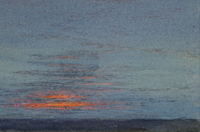Ruskin's Educational series, 1st ed. (1871)
Ruskin's first catalogue of 300 works for the instruction of undergraduates and his notes on the use of particular examples.

Ruskin's Catalogues: 1 object
Show search helpSaint John sees the Seven Lamps Albrecht Dürer
-
Ruskin text
31 F, 31 G. Woodcuts from Dürer’s Apocalypse . Chaps. XVII., XVIII., XLII.Whenever you have no time for long work, copy any piece, however small, of these woodcuts with pen and ink, with the greatest care. I will add sequels to each in a little while; but I do not choose to disturbyour attention by multiplying subjects. I want you to know every line in these two first: then you shall have more.
I give you these two, rather than any others of the series, first, because there is the greatest variety of subject and woodcutting in them; secondly, because Dürer’s power over human character and expression is shown definitely in them, together with his wild fancy; lastly, because they are full of suggestions of thought. I cannot give you any clue to the direct meaning of the chapters illustrated by them; nor will I enter here on any close enquiry as to Dürer’s interpretations. But if you read them in their secondary and general purpose, and consider one as the worship of false wealth and intellect, and the other as the worship of false pleasure, you will probably get nearer their sense than by narrower conjectures. It can hardly be doubtful that Dürer himself, (in his sympathy with whatever part of the Passion of the Reformation was directed against the vices of the Roman Church, but not against its faith,) meant the principal group in No. 40 to indicate the contentment of men of the world in a religion which at that time permitted them to retain their pride and their evil pleasures; and the wonderful figure of the adoring monk on the left, to express the superstition which could not be disturbed by any evidence of increasing sin in the body of the Church. But you had better read all as among the great designs which are produced almost involuntarily by a faithful workman’s mind; and which are capable of teaching different truths to successive generations.
-
Curator’s description:
Description
The 'one like unto the Son of man' (i.e. Christ) sits enthroned, his eyes like flames, a sword coming out of his mouth, holding a book in one hand and seven stars (the angels of the seven churches of Asia) in the other. He is surrounded by clouds, and by seven elaborate candlesticks (often referred to as lamps), each holding a burning candle and representing the seven churches of Asia. Saint John the Evangelist kneels before him, his hands clasped in prayer. The depiction matches the account in Revelation I:10-20, and the print was no. 1 in Dürer's famous "Apocalpyse" series.
Ruskin first catalogued this print in 1870, when it appeared as no. 39 in the Educational Series in the "Catalogue of Examples", representing 'the worship of false wealth and intellect', and accompanied by no. 40 (now WA.RS.ED.125), "The Whore of Babylon", which represented 'the worship of false pleasure'. By the following year, the two prints had changed position, this one being no. 31 G and the "Whore of Babylon" being 31 F in the first catalogue of the Educational Series. They were placed, alongside other Dürers and Holbeins, in Case III, "Illustrations of Northern Gothic, with its resultant Art". In 1872, this print had been moved to accompany the series of Dürers in the second section of the third cabinet in the Rudimentary Series, as no. 69. (The "Whore of Babylon" was moved to no. 125 in the second catalogue of the Educational Series.) Hewison notes that this print was already listed as missing by 1891.
Ruskin wrote about both his "Apocalypse" prints at some length in the "Catalogue of Examples", telling his students to study every line of them, because of the great variety of subjects and wood-cutting technique within them, and the ways they embodied Dürer's power to depict human character and emotion, and also his 'wild fancy'. The 'fantasy and fever' of Dürer's "Apocalypse" was a result of a typically northern 'strange fear and melancholy' which 'took ... a feverish and frantic tendency towards the contemplation of death' and 'brought a bitter mockery and low grotesque into ... art', ("Abbeville" Catalogue, § 24 = XIX.260).
-
Details
- Artist/maker
-
Albrecht Dürer (1471 - 1528) (block cutter)
- Object type
- Material and technique
- woodcut on laid paper
- Dimensions
- [396 x 285 mm]
- Associated people
-
Albrecht Dürer (1471 - 1528) (publisher)
- Inscription
- In the print, engraved, bottom left of centre, Dürer's characteristic monogram
- Provenance
-
Presented by John Ruskin to the Ruskin Drawing School (University of Oxford), 1875; listed as missing in 1891.
- No. of items
- 1
- Accession no.
- RUD.069
-
Subject terms allocated by curators:
Subjects
-
References in which this object is cited include:
References
Schoch, Rainer, Mende, Matthias, and Scherbaum, Anna, Albrecht Dürer: das druckgraphische Werk, 3 (Munich/London/New York: Prestel, 2001-2004), no. 113
Meder, Josef, Dürer-Katalog, ein handbuch über Albrecht Dürers stiche, radierungen, Holzschnitte, deren zustände, ausgaben und wasserzeichen (Wien: Gilhofer & Ranschburg, 1932), no. 165
Bartsch, Adam von, Le Peintre Graveur, 21 vols (Vienna: J. von Degen, 1803-1821), cat. vol. VII, pp. 127-8, no. 62
Ruskin, John, The Ruskin Art Collection at Oxford: Catalogue of the Rudimentary Series, in the Arrangement of 1873, ed. Robert Hewison (London: Lion and Unicorn Press, 1984), cat. Rudimentary no. 69, RUD.069
Ruskin, John, Catalogue of the Educational Series (London: Smith, Elder, 1871), cat. Educational no. 31.G
Ruskin, John, Catalogue of Examples Arranged for Elementary Study in the University Galleries (Oxford: Clarendon Press, 1870), cat. Educational no. 39
Hollstein, F. W. H., German Engravings Etchings and Woodcuts, ca. 1400 - 1700 (Amsterdam: Menno Hertzberger, 1954-), cat. vol. VII, p. 136, no. 165
Bartsch, Adam von, The Illustrated Bartsch, founding editor Walter L. Strauss, general editor John T. Spike (New York: Abaris Books, 1978-), no. 1001.262
Ruskin, John, Instructions in Practice of Elementary Drawing, Arranged with Reference to the First Series of Examples in the Drawings Schools of the University of Oxford (n.p., [1872]), cat. Rudimentary no. 69
Ruskin, John, Instructions in the Preliminary Exercises Arranged for the Lower Drawing-School (London: Smith, Elder, 1872), cat. Rudimentary no. 69
Ruskin, John, Instructions in the Preliminary Exercise Arranged For the Lower Drawing-School (London: Spottiswoode, 1873), cat. Rudimentary no. 69
Ruskin, John, ‘References to the Series of Paintings and Sketches, From Mr. Ruskin's Collection, Shown in Illustration of the Relations of Flamboyant Architecture to Contemporary and Subsequent Art’, Edward T. Cook and Alexander Wedderburn, eds, The Works of John Ruskin: Library Edition, 39 (London: George Allen, 1903-1912), 19
Ruskin, John, ‘The Ruskin Art Collection at Oxford: Catalogues, Notes and Instructions’, Edward T. Cook and Alexander Wedderburn, eds, The Works of John Ruskin: Library Edition, 39 (London: George Allen, 1903-1912), 21, cat. Rudimentary no. 69
Location
-
- not found
Position in Ruskin’s Collection
Ruskin's Catalogues
-
Ruskin's Educational series, 1st ed. (1871)
31 G The worship of Pride. From series illustrating Apocalypse. (Dürer). -
Ruskin's Catalogue of Examples (1870)
39. Woodcut, one of the series of the Apocalypse. (Dürer.) Chap. XLII. -
Ruskin's Rudimentary series, 3rd ed. (1872)
R|69} The Vision of the Seven Churches (woodcut). A. Dürer. -
Ruskin's Rudimentary series 4th ed. (1872)
R|69} The Vision of the Seven Churches (woodcut). A. Dürer. -
Ruskin's Rudimentary series, 5th ed. (1873)
R|69} The Vision of the Seven Churches (woodcut). A. Dürer.





